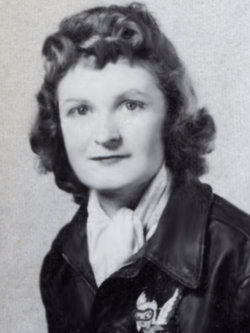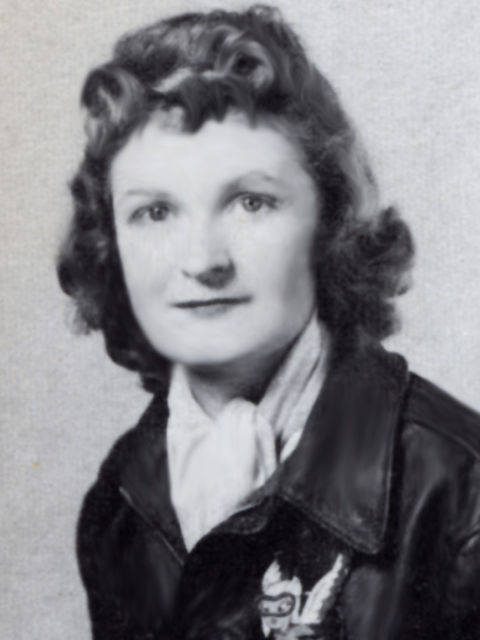After hearing about the WASP training program in Sweetwater, Texas, Louise applied and was accepted into the fourth class in 1943 (43-W-4). She graduated August 7, 1943, earning her silver wings as one of 112 successful pilots out of the 151 candidates who had entered that class. As Louise later said in *Out of the Blue and into History* by WASP Betty Turner, "We flew small planes at first...later larger and faster ones." During an interview for the National Public Radio show, "All Things Considered," in 2002, Louise and six of her WASP cohorts discussed flying some of the behemoth planes trundling off the assembly lines during World War II. She said, "Tears rolled down my cheeks. I just thought, 'Well, I'll never master this. It's too much for me. Take me back to the farm.' But anyway, you get over it. It's a funny thing, but you do." Despite her initial fears and the death of her class roommate in a mid-air collision, Louise persevered, learning to fly at least seven aircraft types. Again in the 2002 interview she said, "We had the best airplanes in the world, the best instructors in the world." After graduation, the US Army Air Force ordered her to report to the Ferry Command at Romulus Army Air Base in Romulus, Michigan from which she delivered many planes to active service.
After WASP deactivation in 1944, Louise earned her instructor's and single- and multi-engine ratings, and taught flying for six years.
She became interested in ministry and served as chaplain at a 125-bed hospital in Fulton, Kentucky for young women inmates of the Hickman, Kentucky jail. She expanded her interest into a full-time, traveling career for the Presbyterian Church. For 21 years, she worked at a 525-bed hospital in Maharastra, West India, then transferred to Kathmandu, Nepal for four years.
After retiring, Louise returned to Kentucky and married Sam Brown. However, she didn't slow her pace. She earned a black belt in Tae Kwan Do. A short time after her husband died, she moved to New Hampshire to be near her sister.
Louise, an extraordinary patriot and a fearless pioneer, is survived by her nephew Gordon Edgan and his wife Janis.
After hearing about the WASP training program in Sweetwater, Texas, Louise applied and was accepted into the fourth class in 1943 (43-W-4). She graduated August 7, 1943, earning her silver wings as one of 112 successful pilots out of the 151 candidates who had entered that class. As Louise later said in *Out of the Blue and into History* by WASP Betty Turner, "We flew small planes at first...later larger and faster ones." During an interview for the National Public Radio show, "All Things Considered," in 2002, Louise and six of her WASP cohorts discussed flying some of the behemoth planes trundling off the assembly lines during World War II. She said, "Tears rolled down my cheeks. I just thought, 'Well, I'll never master this. It's too much for me. Take me back to the farm.' But anyway, you get over it. It's a funny thing, but you do." Despite her initial fears and the death of her class roommate in a mid-air collision, Louise persevered, learning to fly at least seven aircraft types. Again in the 2002 interview she said, "We had the best airplanes in the world, the best instructors in the world." After graduation, the US Army Air Force ordered her to report to the Ferry Command at Romulus Army Air Base in Romulus, Michigan from which she delivered many planes to active service.
After WASP deactivation in 1944, Louise earned her instructor's and single- and multi-engine ratings, and taught flying for six years.
She became interested in ministry and served as chaplain at a 125-bed hospital in Fulton, Kentucky for young women inmates of the Hickman, Kentucky jail. She expanded her interest into a full-time, traveling career for the Presbyterian Church. For 21 years, she worked at a 525-bed hospital in Maharastra, West India, then transferred to Kathmandu, Nepal for four years.
After retiring, Louise returned to Kentucky and married Sam Brown. However, she didn't slow her pace. She earned a black belt in Tae Kwan Do. A short time after her husband died, she moved to New Hampshire to be near her sister.
Louise, an extraordinary patriot and a fearless pioneer, is survived by her nephew Gordon Edgan and his wife Janis.
Family Members
Sponsored by Ancestry
Advertisement
Explore more
Sponsored by Ancestry
Advertisement






